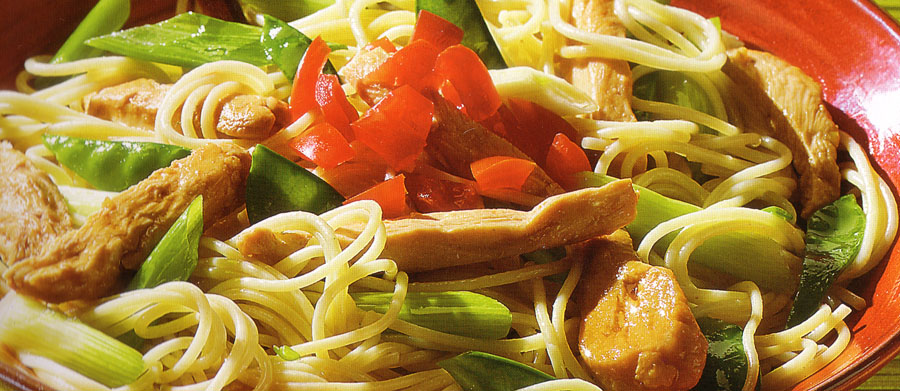
| What is Flavor and Fortune? |
| How do I subscribe? |
| How do I get past issues? |
| How do I advertise? |
| How do I contact the editor? |
Read 13051901 times
Connect me to:
| Home |
| Articles |
| Book reviews |
| Letters to the Editor |
| Newmans News and Notes |
| Recipes |
| Restaurant reviews |
| Article Index (all years, slow) |
| List of Article Years |
| Article Index (2025) |
| Article Index (last 2 years) |
| Things others say |
| Related Links |
| Log In... |
| Authors |
| Categories & Topics |
Chow Mein
| by Jacqueline M. Newman |
Chinese Food in the USA
Summer Volume: 2010 Issue: 17(2) page(s): 25, 26, and 27

 How American is Chow Mein? An article about the origins of Chop Suey in Flavor and Fortune's Volume 10(3) on page 6 and another in Volume 11(3) on pages 10, 13, and 14 exist, but nothing is said about chow mein. That omission sparked a few queries, especially those about the Chow Mein Sandwich discussed in Volume 6(2) on page 6. There is something about chop suey and chow mein in Volume 8(1) on page 26. These articles are on our website for all to enjoy; but still nothing substantive about chow mein.
How American is Chow Mein? An article about the origins of Chop Suey in Flavor and Fortune's Volume 10(3) on page 6 and another in Volume 11(3) on pages 10, 13, and 14 exist, but nothing is said about chow mein. That omission sparked a few queries, especially those about the Chow Mein Sandwich discussed in Volume 6(2) on page 6. There is something about chop suey and chow mein in Volume 8(1) on page 26. These articles are on our website for all to enjoy; but still nothing substantive about chow mein.
One reason might be because less is known about chao mian also known as chow mein. These fried noodle dishes were first known in the United States in the 1850's made by Chinese cooks from Toisan, a rural area in Southern China near Guangzhou. They were dishes related to and made for Chinese workers building America's cross-continental railroad.
Now a staple in Chinese-American restaurants, this dish called Chow Mein is popular in American school cafeterias and on buffets of many an ethnicity and eatery. So common is this dish that Sinclair Lewis mentioned it as early as 1920 in his novel Main Street. These noodle dishes were and still are cooked with pork, beef, chicken, or shrimp, and most often adding celery, onions, bean spouts, and/or cabbage. An early recipe of the 1920's uses all of these vegetables straight out cans. In those days, recipes were written as a single paragraph. It is the first one printed below. It should be noted that back then, it was often served with fried crispy noodles rather than those steamed and soft as made in Southern China where the dish began. But that is before its trek to the United States.
No matter how served, this generic-named dish varies from restaurant to restaurant, city to city, even country to countr; and it continues to vary. For example, with an increase in Indian-Chinese restaurants in the last decade, the Chinese from Calcutta and other cities in India brought theirs, best known as 'Hakka Chow Mein' to the United States. Many of these immigrants eat halal, that is religiously following dietary proscriptions, and many are vegetarian. To remind them of tastes adored in India before immigrating, many of their restaurants serve it with gravy and following halal dietary rules.
Tap seui or chop suey, also spelled tsa sui, does mean 'mixed pieces' while chow mein means 'fried noodles.' Either or both are prepared with different seasonings depending on country, city, site, or person cooking the dish. Soy sauce is a most common seasoning, everything else can and often is different. Chow mein noodles can be thick or thin, made as rope, pulled, threaded, pressed, or rolled and cut into strips, squares, etc. The noodles themselves can be made with wheat flour, wheat and rice flour, plain rice flour, and/or other ingredients such as bean threads, agar agar (a seaweed), egg noodles, e-fu noodles, buckwheat noodles, etc. In China, this dish usually incorporates basic flavors of sweet, salty, bitter, pungent, and sour and not always made with all these tastes in the United States.
Often queried as to how old this dish is in China, several Chinese food historians report people ate noodles boiled and plain or noodles mixed with other foods as early as the late Han Dynasty, a dynastic period ending in 220 CE. Supporting these claims, be aware that noodles were found in Han Tomb # 3 at Mawangtui.
During the Song Dynasty (960 - 1279 CE), people were also eating noodles as candy. There are articles about this food called Dragon Beard Candy in Flavor and Fortune’s Volume 11(2) on page 8, Volume 13(2) on page 30, and in Volume 13(3) on page 6.
In early China, chow mein was eaten with a spoon; now everyone eats theirs using chopsticks, except in Italy, where spoon and fork or spoon and chopsticks are the popular eating implements. Most chow mein noodles are white or light tan. In earlier times, some juices of radish or locust leaves were added to the dough making the noodles reddish or light green. One early Chinese book has a noodle dish that could be chow mein, but it does not call them that. It is Madame Wu's Recipe Book written during the Song Dynasty (960 - 1280 CE). It pulls and stretches its noodle dough. Though made this way, it calls the dough 'sliced noodles.'
In the United States, almost all early Chinese cookbooks have one or more recipes for this dish. In the first Asian cookbook, called Chinese-Japanese Cookbook, a 1914 volume published in the United States and written by two American sisters, Sara Bosse and Onoto Watanna, there are three chow mein recipes, all different. Republished in 2006 by Applewood Books (ISBN 1-55709-371-7), these recipes are titled: Meat Chow Main, Chicken Chow Main, and Lobster Chow Main. The one with lobster, as written in that volume, is the one printed below. For the record, this particular cookbook includes five recipes for Chop Suey.
The 1928 Mandarin Chop Suey Book has three recipes for Chow Mein. A 1933 volume titled: Nellie Wong's Dishes for Foreign Homes published in English in China, also has three recipes for this dish. One of them says it is made Chinese style, the other two American style.
Different recipes for Chow Mein abound as do different stories about this dish. One credits a Japanese chef serving it to a visiting general. That story, more often credited to Chop Suey, has been debunked as a tall tale. Andrew Coe in his book titled: Chop Suey (published by Oxford University Press in 2009; ISBN 978-0-19-533107-3) advises that chow mein cooked in China's Pearl River Delta was a distinct dish, but that in New York City's uptown joints' chow mein was simply chop suey served over fried noodles instead of over or with rice. Coe also says, speaking of the diet in the United States, that by the 1920's "chop suey and chow mein had claimed a place in the national diet."
Chow Mein made with fried noodles is not the same dish served in China where soft noodles are used that were boiled and then stir-fried in hot oil until crisp on the outside but soft within. It is served with a stir-fried mixture of vegetables and strips of meat. Gloria Bley Miller in her Thousand Recipe Chinese Cookbook published by Grosset and Dunlap in 1970 (ISBN 0-448-00674-X) calls chow mein a "casual dish which calls for boiled noodles to be cooked with other ingredients somewhat in the manner of fried rice; that is, the noodles and other ingredients...fried separately, then combined and cooked until nearly done." Her book has five chow mein variations plus one titled: Miscellaneous.
E.N. Anderson (a retired professor of Anthropology who taught at the University of California, Riverside and authored The Food of China published by Yale University Press in 1988, believes the real background of chow mein or fried noodles is in Northern China where wheat was and is the staple crop. He writes their introduction to the United States is, however, from Toisan. He says it is cooks from that southern Chinese region who prepared it cooking for railroad workers in the United States who later opened restaurants. He goes on to say that Chinese and non-Chinese sampled their fare, appreciated its taste and ingredients, and liked both the quick service and the price.
Among the last two recipes, the first is from Perfect Chinese, no author given. It is a Parragon Publishing book indicating that it was first published in 2007 in Bath, UK. The last recipe below is that same recipe rewritten in the style of one found in southern China today.
| Chow Mein in the 1920's |
|---|
| Lobster Chow Main |
|---|
One pound of lobster meat; two eggs; one half pound of noodles; three stalks of celery; one can of bamboo shoots; one onion; one quarter pound of
mushrooms; one tablespoon of sweet lard; one quart of peanut oil; three water chestnuts. First boil the peanut oil and into it throw the noodles, cooking until crisp. Remove and drain, while preparing following: Put teaspoon of sweet lard into frying pan, and when hot turn in half the lobster meat, which has previously been cooked (Canned lobster will do as well.) Cook for a few minutes, then add the onion, mushrooms, and water chestnuts. The bamboo shoots are added last, and all fried for ten minutes. Take a hot platter, and place the crisp noodles as a layer at the bottom of the dish, and spread above ingredients on top. Then take the other half of the lobster meat, and place a layer on top. Garnish with shredded yolks of hard-boiled eggs. |
| Chicken Chow Mein, UK 2007 |
|---|
9 ounces dried egg noodles 2 Tablespoons sunflower oil 10 ounces cooked chicken breasts, shredded 1 garlic clove, peeled and finely chopped 1 red bell pepper, seeded and thinly sliced 3 and ½ ounces Chinese black mushrooms sliced 6 scallions, sliced on an angle 3/4 cup bean sprouts 3 Tablespoons soy sauce 1 Tablespoon sesame oil Preparation: 1. Place egg noodles in a large bowl and break them up slightly. Pour enough boiling water over them to cover, and let stand while preparing the other ingredients. 2. Preheat a wok over medium heat. Add the sunflower oil and swirl around to coat the sides of the wok. When oil is hot, add chicken, garlic, red pepper, mushrooms, scallions, and bean sprouts and stir-fry about five minutes. 3. Drain the noodles thoroughly, then add to the wok, toss well, and stir-fry an additional five minutes. Drizzle soy sauce and sesame oil and toss until thoroughly combined. 5. Transfer to warmed serving bowls and serve immediately. |

Copyright © 1994-2025 by ISACC, all rights reserved
Address
3 Jefferson Ferry Drive
S. Setauket NY 11720